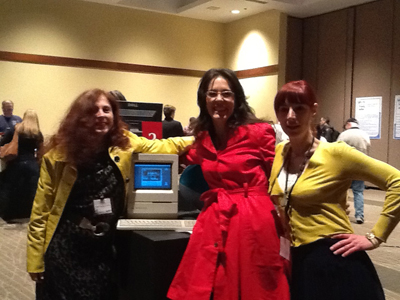Session: #PS08
Session Title: “Excavating Feminisms: Digital Humanities and Feminist Scholarship”
With Katherine D. Harris; Jacqueline Wernimont; Kathi Inman Berens; and Dene Grigar
Location: CBA 143
Session Chair: Purdom Lindblad
“hooks in the 21st Century: Feminist Pedagogy in Action,” by Dene Grigar
Part 1: Introduction
In 1994 belle hooks wrote in Teaching to Transgress: Education as the Practice of Freedom that “[t]here is a serious crisis in education. Students often do not want to learn and teachers do not want to teach . . . “ (12). A clear lack of excitement in the classroom, which some see as “disruptive of the atmosphere of seriousness,” as well as a lack of engagement and of freedom to explore are among some of the ills she cites in her book (6-10). hooks’ call to action empowered many feminist teachers to experiment with new teaching strategies, to address the needs of the whole student, and to become with their students active participants in the learning process––in short, it inspired us to embrace what she refers to as “transformative pedagogy” (39).
In 2006 I arrived at Washington State University Vancouver to build the Creative Media & Digital Culture Program, bringing with me the principles of transformative pedagogy and eager to apply them to the digital media classroom. This presentation lays out the approaches and projects that I and the faculty in the program undertook in the last seven years and the positive outcomes for students, faculty, and staff for this grand experiment. One example highlighted is the Mobile Tech Research Initiative (MTRI), a project that provided all of the faculty, staff, and 10 students, during summer 2011, to learn––together––how to design for and develop mobile apps. MTRI provided our program with the ability to integrate mobile media into our curriculum; our students were able to receive fully funded fellowships and were fast-tracked through the program and land good jobs and placement in graduate programs specializing in interactive design; and faculty have been able to continue creating mobile media for their scholarship. As such, the presentation provides those interested in transformative pedagogy with best practices for applying this approach to teaching in their classroom. As hooks reminds us, “[t]he academy is not paradise. But learning is a place where paradise can be created” (207). In light of the challenges education faces today, what she has to say is about teaching and learning twenty years ago is still pertinent today, perhaps even more so.
Part 2: Transformative Pedagogy, and the CMDC Program
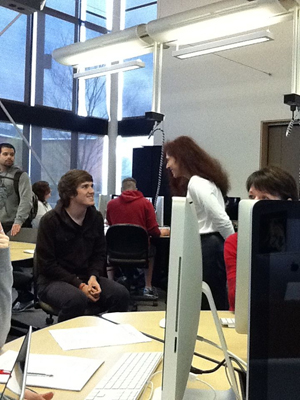 What is transformative pedagogy, and how was it applied to the CMDC Program? According to hooks, it is a pedagogy that “makes education the practice of freedom” (12) and is expressed through student-centered, holistic, and praxis-oriented approaches that allow students to create their own knowledge.
What is transformative pedagogy, and how was it applied to the CMDC Program? According to hooks, it is a pedagogy that “makes education the practice of freedom” (12) and is expressed through student-centered, holistic, and praxis-oriented approaches that allow students to create their own knowledge.
hooks’ concern about education are many (e.g. that it “merely strives to reinforce domination,” that many professors lack “basic communication skills,” that “excitement” about learning is viewed as “disruptive,” that professors do not “value” students’ presence), but her overarching concern is a resistance to a “philosophical standpoint emphasizing the union of mind, body, and spirit, rather than the separation of these elements” (18)––what she sees as “holistic approach to learning” (14) that has at its center a goal of enlightenment along with the acquisition of knowledge. This approach results in an “engaged pedagogy” (21) in which “teachers [also] grow, and are empowered by the process” (21).
I had come to WSU Vancouver after teaching 12 years at a publicly funded women’s university in Texas where a deep study of hooks and other feminist writers and theorists had played a large role on our campus. Teaching to Transgress was one of the books that the faculty read together in the formal study group of the Women’s Study program where I served as affiliate faculty and taught courses, like Feminist Theory (entitled Feminist Cyberculture, Summer 1999) for the graduate students in the program.
In order to integrate transformative pedagogy into the CMDC Program, I began by spending the first semester getting to know the students and faculty, the wider community, the program, and the university. This time period made me realize that the region was in great need for expertise and leadership in digital media and that a great many students wanted to learn how to make the objects they were studying in their classes. During the winter break, the faculty met to begin a self-study exercise. The question we posed to ourselves was, What should a graduate of this program know and understand (about digital media and the world at large) after completing the major? Once we answered this question, we were able to go through the curriculum to see if the program, indeed, offered the appropriate courses to achieve this vision. This exercise led to the development of 10 Goals and Objectives that the faculty implemented during the next semester.
We also realized that we as a faculty needed to be clear about our own philosophy of digital technology so that we could work together coherently despite the fact we all hailed from different academic backgrounds (i.e. Humanities, Fine Art, Library Science, Rhetoric and Linguistics, Anthropology, English). This exercise gave rise to guiding principles that we, as a faculty, viewed as central to our philosophy of teaching and research for digital media. Now numbering 10, these philosophical concepts/guiding principles (listed below) are introduced to students in their courses and continue to be fine tuned each semester at our faculty retreats:
- A computer is not a tool or prosthesis that helps us to accomplish something; rather, it is the medium in which we work. (Oliver Grau, MediaArtHistories, 2007)
- Text is any form of information by which we communicate an idea, feeling, or concept. (Mats Dahlstrom, “When Is a Text Text?,” 2002)
- The medium affects the message. (Marshall McLuhan, The Medium Is the Massage, 1967)
- Digital media are material texts. (N. Katherine Hayles, Writing Machines, 2002)
- The artifact of new media is just as important as the process it took to produce it. (Jan Van Looy & Jan Baetens, Close Reading New Media, 2003)
- Making is not separate from thinking. (Stephano Vannotti, “Let Us Do What We Do Best: But How Can We Produce Knowledge by Designing Interfaces?,” 2008)
- The design of information is a conversation about ideas––not about persuading people to do things. (Robert Jacobson, “Information Design,” 2000).
- Criticism of digital media should be specific to digital media and relies on the sensory modalities of the body for that critique rather than abstract ideas or theories. (N. Katherine Hayles, Writing Machines, 2002)
- Digital media involves an interdisciplinary/transdisciplinary study of art, science, and technology (Edward Shanken, Telematic Embrace, 2003) & the Humanities.
- The hallmark of a digital scholarship is “collegiality,” “openness,” and “collaboration” (Tom Scheinfeldt, “Why Digital Humanities Is Nice,” 2012)
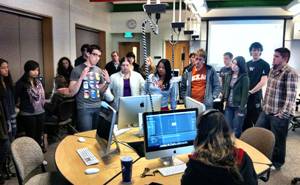 To put these concepts into perspective, it means that our courses involve hands on experiences for its students (#1) with emphasis not only on visual communications but also aural as well as gestural, etc. (#2). Students in such courses would be taught that moving print information to a website, for example, requires more than cutting and pasting text to the new environment but rather a careful consideration of the affordances the new medium makes available that the old one does not (#3). It also suggests that what students create is “real” and potentially can impact, in important ways, the society in which they live because of the objects’ “virtuality” (#4)–– and because this potential does exist, creating media objects requires a strong ethical base from which to create. It also means that a successful completion of a media object is greatly influenced by the viability and usability of the object itself, as well as its aesthetic quality (#5). Thus, students learn that critical thinking and problem-solving sit at the foundation of everything they make (#6) and that the object may have many important uses, and so is not created solely to lead others into a particular action or to embrace a particular idea (#7). Students also learn to embody their work and to make sense of it through their own experiences, as well as those others may have experienced it (#8). Because each individual brings to the classroom unique backgrounds and training as well as personal interactions with information, it is understood that knowledge of multiple disciplines and teaching methods are needed to be implemented in the classroom of a digital media course (#9). And because so much of the work produced requires teamwork, those involved in the theory and production of digital objects work together in a manner that is collegial and open (#10). The active, engaged approach to learning focus on the uniqueness of the individual, and heavy emphasis on ethics all speak to hooks’ notion of transformative pedagogy.
To put these concepts into perspective, it means that our courses involve hands on experiences for its students (#1) with emphasis not only on visual communications but also aural as well as gestural, etc. (#2). Students in such courses would be taught that moving print information to a website, for example, requires more than cutting and pasting text to the new environment but rather a careful consideration of the affordances the new medium makes available that the old one does not (#3). It also suggests that what students create is “real” and potentially can impact, in important ways, the society in which they live because of the objects’ “virtuality” (#4)–– and because this potential does exist, creating media objects requires a strong ethical base from which to create. It also means that a successful completion of a media object is greatly influenced by the viability and usability of the object itself, as well as its aesthetic quality (#5). Thus, students learn that critical thinking and problem-solving sit at the foundation of everything they make (#6) and that the object may have many important uses, and so is not created solely to lead others into a particular action or to embrace a particular idea (#7). Students also learn to embody their work and to make sense of it through their own experiences, as well as those others may have experienced it (#8). Because each individual brings to the classroom unique backgrounds and training as well as personal interactions with information, it is understood that knowledge of multiple disciplines and teaching methods are needed to be implemented in the classroom of a digital media course (#9). And because so much of the work produced requires teamwork, those involved in the theory and production of digital objects work together in a manner that is collegial and open (#10). The active, engaged approach to learning focus on the uniqueness of the individual, and heavy emphasis on ethics all speak to hooks’ notion of transformative pedagogy.
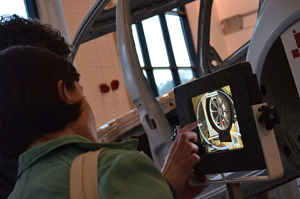 Transformative pedagogy involves, as hooks suggests, a “revolution of values” (23) and embraces Martin Luther King’s notion of the “shift from a ‘thing’-oriented society to a ‘person’-oriented society” (27). To get across such a view, the CMDC program has a strong focus in helping others through community outreach activities. Since the summer of my first year in the program, students and faculty have created videos, animations, augmented reality environments, websites, mobile apps, social media strategies and other media objects for non-profits like the Council of the Homeless, the Boys and Girls Club, At Home at School, the Oregon Museum for Science and Industry, Fort Vancouver National Historic Site, the Community Foundation for Southwest Washington, to name a few. These endeavors serve to imbue a commitment to others and help students see that they are part of a larger community.
Transformative pedagogy involves, as hooks suggests, a “revolution of values” (23) and embraces Martin Luther King’s notion of the “shift from a ‘thing’-oriented society to a ‘person’-oriented society” (27). To get across such a view, the CMDC program has a strong focus in helping others through community outreach activities. Since the summer of my first year in the program, students and faculty have created videos, animations, augmented reality environments, websites, mobile apps, social media strategies and other media objects for non-profits like the Council of the Homeless, the Boys and Girls Club, At Home at School, the Oregon Museum for Science and Industry, Fort Vancouver National Historic Site, the Community Foundation for Southwest Washington, to name a few. These endeavors serve to imbue a commitment to others and help students see that they are part of a larger community.
For-profit businesses respect our mission and have supported ongoing educational opportunities for students and faculty. One of these, the Mobile Tech Research Initiative (MTRI) funded for $68K by Dick Hannah Dealerships, provides a good example for how transformative pedagogy has worked for the CMDC program.
Part 3: The Mobile Tech Research Initiative
The Mobile Tech Research Initiative (MTRI) was envisioned as a partnership between the university and community that would help rebuild Vancouver’s economy by introducing a new, creative industry––the development of mobile apps for smart devices. The bad economy hit the region hard, and small businesses owned by our students and their families were failing at an alarming rate. Many students were unable to attend college, and some who did had lost their homes and livelihood. Those who could find work were earning less and working more. The faculty felt they had to do something bold to affect some change. We had built a good relationship with Dick Hannah Dealerships, a regional company who had begun to hire our graduates. We talked to the owners about funding a summer fellowship that would educate both faculty and students about mobile media design and development, and the owners agreed.
MTRI focused on teaching the design and development of mobile apps in a series of four courses organized around the two 2011 summer sessions. Its goals were to: 1) develop a local body of expertise in the emerging technology field of mobile application design and development, 2) contribute actively to undergraduate research, an important mission of WSU Vancouver, and 3) promote STEM education from K through college by fostering local synergies among the digital media, science, and business communities. This last goal helped to integrate digital media and the digital humanities into conversations about STEM, which until then, did not include our program and students.
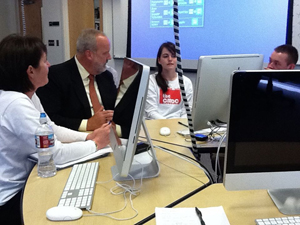 What made MTRI special was its approach to learning. Following hooks’ notion of transformative pedagogy, once again, faculty learned alongside the 10 student “Fellows” selected for the program, attending classes and sharing mutual expertise in the areas both faculty and students had knowledge of. One recent graduate who knew Objective C for app development, for example, was hired to co-teach and oversee the groups’ programming efforts. Everyone engaged in hands-on learning, which resulted in the development of three mobile apps (one for Dick Hannah Dealerships, one for a local film festival, and another for a small local business), and students took on leadership roles (e.g. Project Manager, Lead Designer, Lead Coder). The end result was work students themselves conceptualized and produced was used by organizations.
What made MTRI special was its approach to learning. Following hooks’ notion of transformative pedagogy, once again, faculty learned alongside the 10 student “Fellows” selected for the program, attending classes and sharing mutual expertise in the areas both faculty and students had knowledge of. One recent graduate who knew Objective C for app development, for example, was hired to co-teach and oversee the groups’ programming efforts. Everyone engaged in hands-on learning, which resulted in the development of three mobile apps (one for Dick Hannah Dealerships, one for a local film festival, and another for a small local business), and students took on leadership roles (e.g. Project Manager, Lead Designer, Lead Coder). The end result was work students themselves conceptualized and produced was used by organizations.
The initiative also resulted in Dick Hannah Dealerships hiring two Fellows and the alum who taught in the program, and OMSI also hiring one. Other Fellows had no difficulty getting jobs or in graduate school following graduation. The CMDC faculty were able to integrate mobile media design and development in all of the program’s curriculum and have taught a course on the subject at the Digital Humanities Summer Institute at the University of Victoria in 2012 and 2013, and workshops in and around the region since summer 2011. The project built the first of a cohort for the newly independent CMDC program and set the pace for ongoing summer initiatives on 2D animation (Summer 2012) and iPublishing (Summer 2013) that have taken place since that have also funded student Fellows.

Part 4: Ecstasy and Joy
hooks concludes her book with a chapter on “ecstasy” where she tells us (despite contemplating leaving the profession) that “[a]fter twenty years of teaching, I can confess that I am often most joyous in the classroom, brought closer here to the ecstatic than by most of life’s experiences” (206). The classroom, she reminds us, “remains a location of possibility” where we “labor for freedom, . . . demand of ourselves and our comrades, an openness of mind and heart that allows us to face reality even as we collectively imagine ways to move beyond the boundaries, to transgress. This is education as a practice of freedom” (207). I have to admit to a similar joy and pride in my students’ accomplishments. They are getting jobs that allow them to feed themselves and form their own family units. They are taking up leadership roles in the community, serving on political, cultural, and artistic committees. They are getting into graduate programs when they wish to. They are winning awards for their work. They have formed networks among themselves, giving support to one another when needed. All of this brings me joy and reminds me that, as hook tells us, “[c]ommitment to engaged pedagogy carries with it the willingness to be responsible, not to pretend that professors do not have the power to change the direction of our students’ lives” (206).

